I guess the better question is.. Why is he doing it?
Three weeks ago I documented some very puzzling behavior from an American Crow at Farmington Bay WMA.
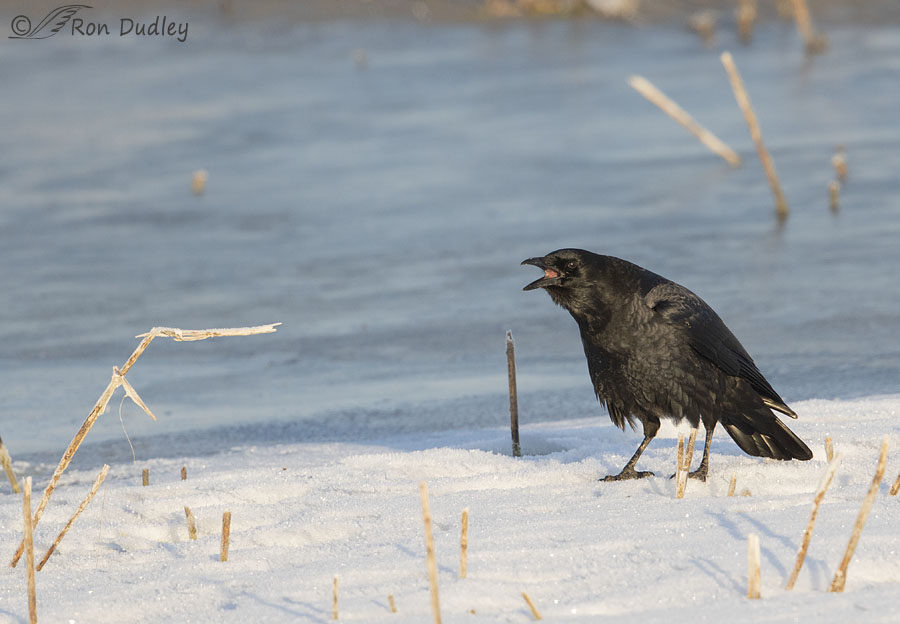
1/1250, f/6.3, ISO 800, Canon 7D Mark II, Canon EF 500mm f/4L IS II USM + EF 1.4 III Extender, not baited, set up or called in
There were lots of crows in this area of standing water that was frozen solid that morning but I was watching this one because he/she was closest and because his behavior seemed just a little different somehow. Mostly I was just watching him without firing off any shots but then things got interesting.
As he approached the largest bent-over phragmites stalk remnant on the far left he stopped and then appeared to scold that stalk by repeatedly calling in its direction.
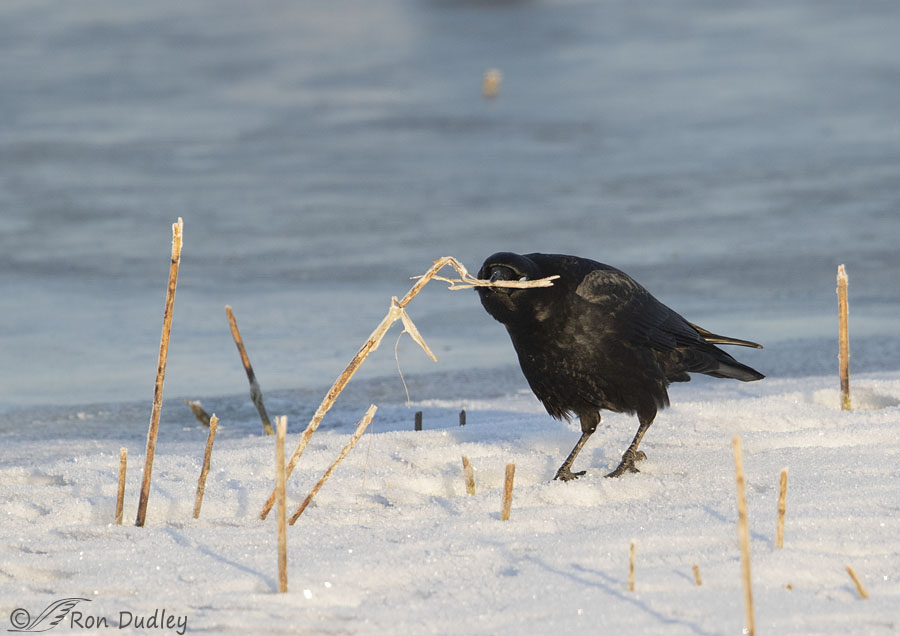
1/1000, f/6.3, ISO 800, Canon 7D Mark II, Canon EF 500mm f/4L IS II USM + EF 1.4 III Extender, not baited, set up or called in
Then he walked over to that particular stalk, grabbed it in his bill and pulled it out of the snow.
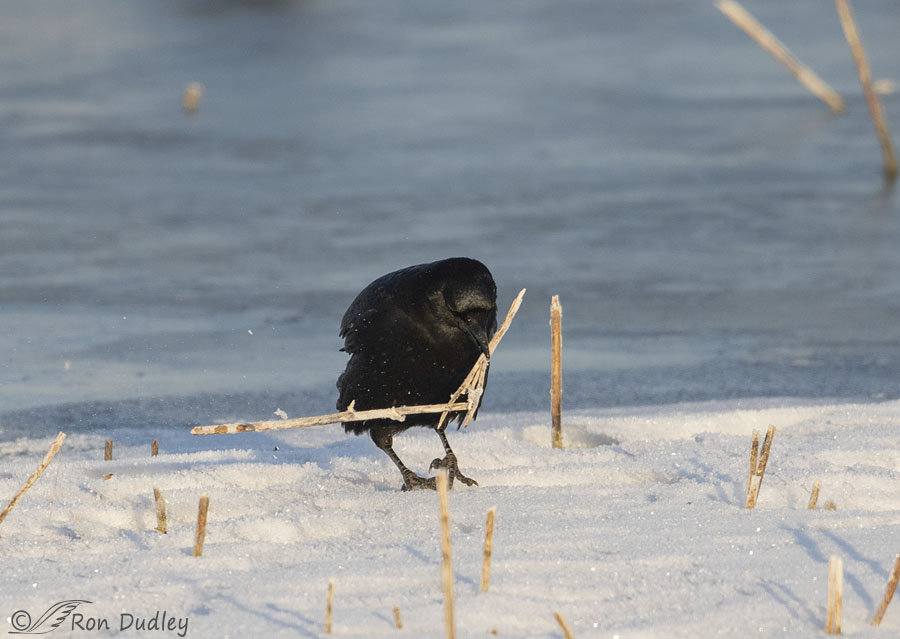
1/1600, f/6.3, ISO 800, Canon 7D Mark II, Canon EF 500mm f/4L IS II USM + EF 1.4 III Extender, not baited, set up or called in
He manipulated it in his bill for a few moments and then…
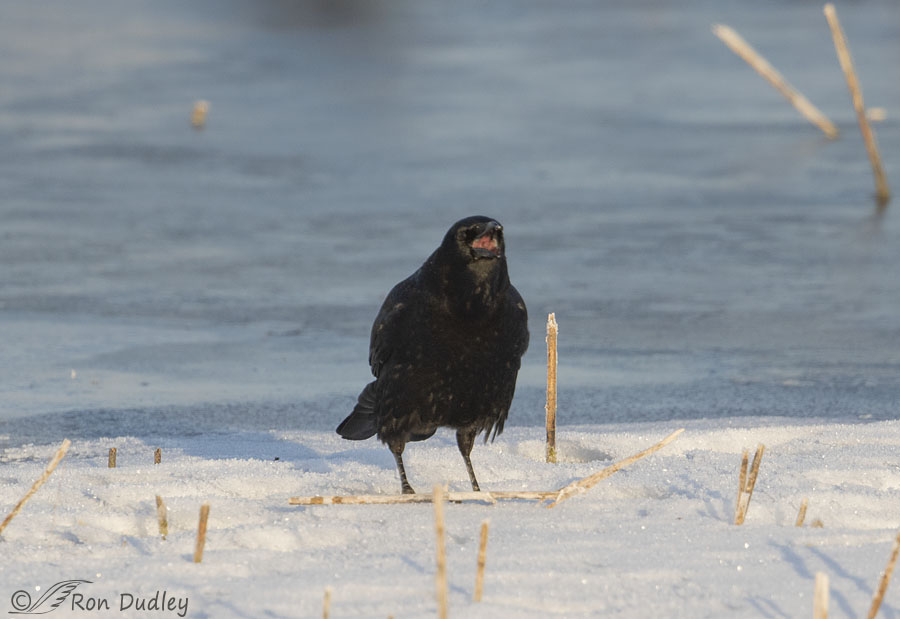
1/1250, f/6.3, ISO 800, Canon 7D Mark II, Canon EF 500mm f/4L IS II USM + EF 1.4 III Extender, not baited, set up or called in
dropped it in front of him. Then he appeared to scold the stalk (or something, maybe another crow or even me) some more.
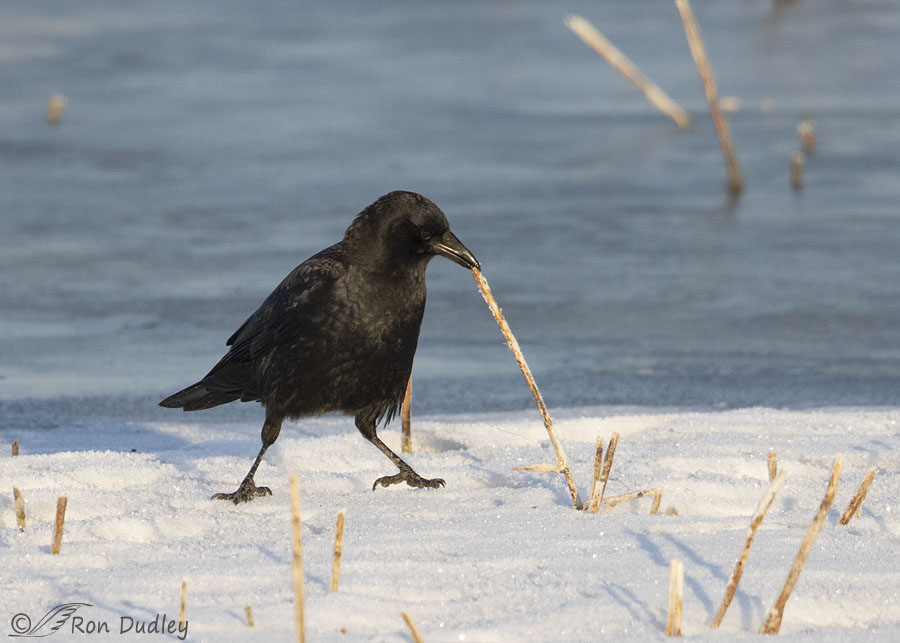
1/2500, f/6.3, ISO 800, Canon 7D Mark II, Canon EF 500mm f/4L IS II USM + EF 1.4 III Extender, not baited, set up or called in
He picked it up again, removed its frayed end and some short projections along its length and then carefully and deliberately “planted” it in the snow, taking care to….
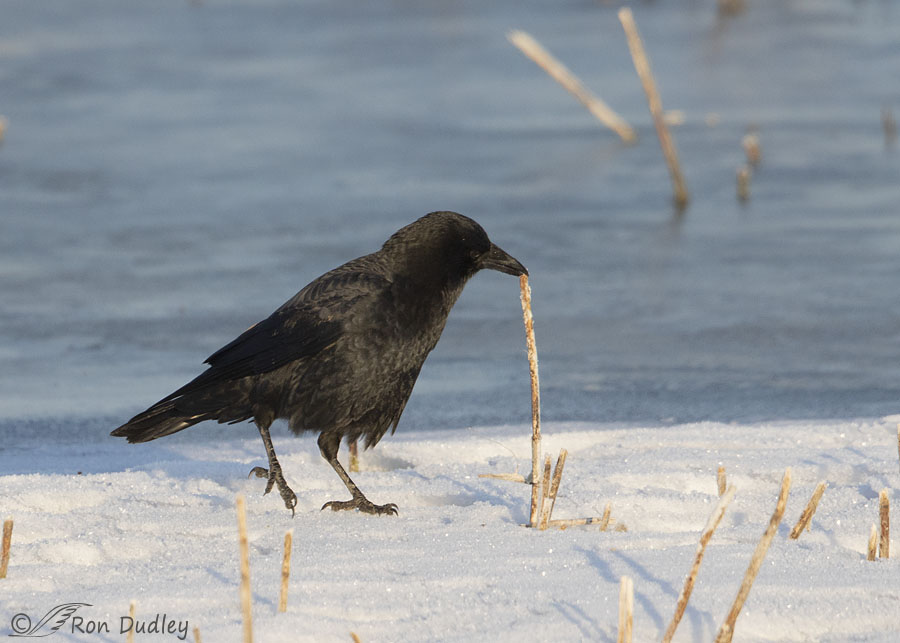
1/2000, f/6.3, ISO 800, Canon 7D Mark II, Canon EF 500mm f/4L IS II USM + EF 1.4 III Extender, not baited, set up or called in
make sure that the stalk was planted at an almost perfectly vertical angle.
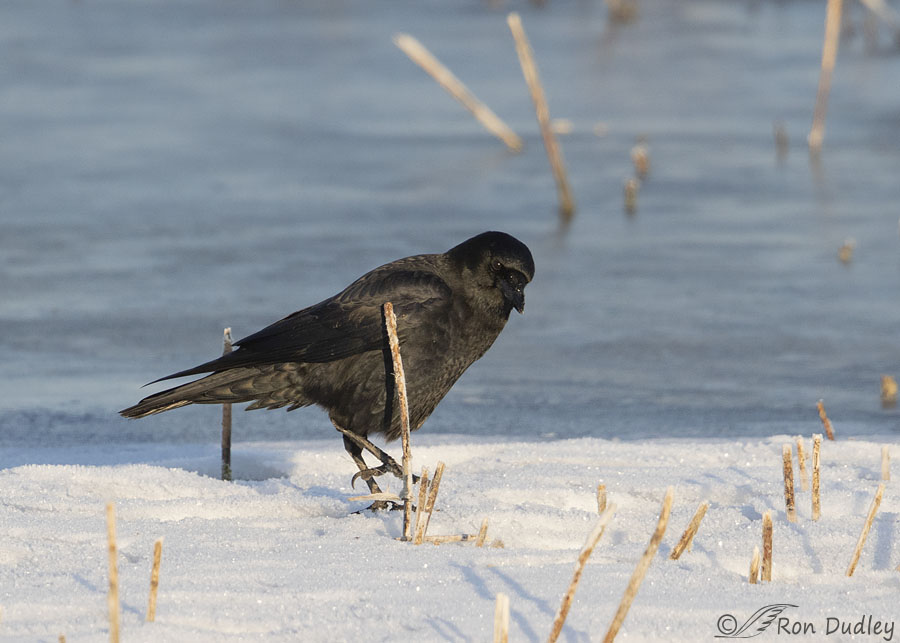
1/1600, f/6.3, ISO 800, Canon 7D Mark II, Canon EF 500mm f/4L IS II USM + EF 1.4 III Extender, not baited, set up or called in
And then he nonchalantly walked away, inspecting his handiwork as he left it behind.
I’m convinced that this was no random act with no purpose or meaning but I have no idea what it might be. Perhaps it was a form of play or experimentation or maybe even some type of communication with other nearby crows. I’m stumped but I’m truly fascinated and intrigued at the same time.
Corvids are known for their intelligence and crows are among the smartest of the bunch. They’re known for making and using tools, solving problems, having a diverse vocabulary (including mimicking human speech), participating in creative play and even for anticipating future events and other individuals’ states of mind. Researchers consider crows to be as bright as a typical seven year old child.
One of my favorite examples of crow intelligence (and perhaps playfulness) is one cited by Cornell’s Birds of North America Online where wild, breeding female crows broke off pine cones and repeatedly dropped them on the heads of humans climbing their nest tree. Now I would dearly love to see that but it doesn’t explain what was going on with “my” crow.
If reincarnation exists I want to come back as a bird behaviorist. And I’m not kidding.
Ron
PS – Phragmites is an invasive plant known for propagating and spreading in marshlands at near-unbelievable rates. Wouldn’t it be something if crows turned out to be sort of the Johnny Appleseed of the phragmites world (he says with tongue firmly planted in cheek).
Late Addendum: In a comment below Sybby suggested that I send a link to this post to Dr. Kevin McGowan at the Cornell lab. Dr. McGowan has studied crow behaviors for decades so that’s what I did. Following is his response:
- “Interesting. Definitely a young crow. Crows don’t really “grow up” until they’re two years old, and so you can see them doing play-like things throughout the first year. Sometimes it’s just extended bouts of calling, other times it’s manipulating objects and hiding small, non-food things. I’ve seen them pick up and peck lots of items, but I’ve never seen them plant anything like the way you did.”


I have watched corvids make fake caches to hide from their companions where the true cache is. I once watched a Woodhouse’s Scrub Jay make half a dozen fake caches with a peanut then finally hide the peanut in the general area. He sat in a nearby tree and watched for 20 minutes to see if anything was looking. He flew back to a couple of the fake caches and put a bit more bracken on top.
Thanks. I love that!
That crow has OCD. The stalk wasn’t “right” so the crow had to make it right. LOLOLOLOL
Could be… 🙂
Did you notice that most of the other stalks in your picture were more aligned with straight up? It may have been aligning a stray stalk.
Biven the intelligence of corvids it’s always possible, Elmer. I know I have that anal tendency…
Glad you sent the information and got a prompt reply! 🙂 More things to learn and for you to add a new behavior to the list of things they do!
Back in the 80’s I was driving home from work. I decided to drive by the local State College. I had to stop due to the red light, and it was a long light. To the right of me was the Agriculture area of the College. There was a huge dirt pile with huge dirt clod’s that rested on top of the pile. Ravens were sitting on the fence near the street. People were honking their horns, and I watched the birds. “They are so adaptable”..Well one Raven wasn’t having any of the long line of cars, or the noise they created. He/she flew off to the dirt pile. Picked up two dirt cold’s, and flew behind me. I didn’t think this was going to be good. I saw the Raven’s shadow behind me, and was looking like crazy, hoping he didn’t bomb my car. Well, he didn’t, he bombed the car in front of me. A elderly couple who never even noticed the birds. They were looking all over the place with a “what the heck” look on their face. The Raven went back to reload, and was flying overhead again. I was saved by the green light, and didn’t get hit. I still laugh about that to this day. Yes, the are smart birds. Too smart! lol
That’s a funny story, Jean. I’d love to have seen what you did.
Ron, I think he was playing with your mind. I sure enjoyed the pics and thank you much. Hope your back continues to improve. Diana
He very well may have been, Diana. Thank you.
I think he was doing an Andy Crowsworthy!
All corvids seem to provide us endless hours fascination if we only take the time to watch. I don’t have an expiation any better than what others have offered, but it’s things like this that gave this old biologist a life-long career studying and teaching about birds. There’s always more to see and learn and it’s always worthwhile. Thanks for sharing.
“it’s things like this that gave this old biologist a life-long career studying and teaching about birds.”
Ha, you could have written that about me, Dan – it fits me almost as well as it does you, but not quite (I taught about all life forms, not just birds).
My job actually involved working with most undergraduate biology lab courses (microbiology, plant physiology, cell biology, etc., etc.) but teaching the ornithology course was by far the most rewarding part of my life. I still find ways to teach about birds even in retirement.
Then it applies to both of us about equally – especially since we both continue to teach about birds in retirement.
OK, my turn to guess. The red in the mouth tells us that this is last year’s chick, coming into his first spring. I’m guessing that somewhere in his/her birdie brain there is a glimmer that he’s supposed to do something with sticks and grasses in the springtime, but doesn’t have a clue yet what that might be. Maybe if I play with the stuff, it will come to me. Speculating that in a few weeks he’ll see another conspecific working on a nest, and go “Aha! That’s it!” Corvids have instinctual behaviors, but those are fine tuned by observing relatives and experimenting. He may or may not try nesting this first year, and may or may not be successful at raising chicks. He might even help mom and dad this year. But guaranteed he’ll keep working on it until he’s skilled.
I think your guess is as good as any, maybe better, Mikal. It’s interesting to speculate, isn’t it.
Let me propose that you send this as a note to the Cornell Bird Lab.
Hmmm, maybe…
Wonderful documentation of bird behavior, Ron.
Me thinks one would have to be a crow to comprehend some of their behaviors. I have a hanging platform feeder in the yard on which I put mixed nuts sold as squirrel food (although it is squirrel-proofed so only birds have access). The crows are the only birds that can handle such big nuts. Lately, they won’t touch the almonds; at other times they leave the macadamia nuts or hazelnuts. Is it taste, freshness, or some other quality?
John Marzluff has demonstrated that crows can readily identify individual people. The reverse, as far as I know, is not the case. Certainly makes one ponder the nature of intelligence.
“John Marzluff has demonstrated that crows can readily identify individual people. The reverse, as far as I know, is not the case. Certainly makes one ponder the nature of intelligence.
That’s a fascinating observation, Lyle. Under normal circumstances I certainly cannot identify individual crows.
I’ve corrected your typo and deleted your correcting comment.
I think you should forward this post to Dr. Kevin McGowan at the Cornell Lab of Ornithology. He has spent decades researching corvid behavior and I’m sure he’s love to see this. I’ve met him a few times and he was very friendly with a good sense of humor. I hope your back is feeling better in time for Spring birding action. 🙂
That’s an interesting suggestion, Sybby. I’ll have to ponder it…
Ok, I sent the link to Dr. McGowan, Sybby. Usually when I’ve sent stuff similar to this to Cornell (most often to their BNA Onlne) I don’t get much response but if I hear anything interesting back I’ll report it here.
I read an amazing article 30 years ago on what could possibly be going on in the mind of a cat. It might be worth your time to write about what goes on inside the mind of a bird?
Ha, I wish I knew, Elmer!
Stephen Jay Gould wrote that he would liked to have spent five minutes as a bird doing what birds do. When I read that quote to my late husband, he laughed and said I would never be satisfied with just five minutes. I suspect he was right. Would five minutes do it for you?
“Would five minutes do it for you?”
Not a chance, Shirley. It would only whet my appetite, especially after I realized I could fly!
There’s no question that’s intentional behavior. By the time he “re-planted” that bit of stalk, I was completely hooked. When I first began nature photography, flowers were my preferred subject, but I soon learned that there was a lot of living going on in those flowers. As you say, being able to review images brings some amazing details to light.
I’m convinced it was intentional behavior too, Shoreacres.
I’ve always been interested in animal behaviors (I even took a vertebrate behavior class in college) but when I first took up bird photography “pretty pictures” were my primary objective. But it didn’t take me long to gravitate towards behaviors in my photography too – a high quality and powerful lens made it almost inevitable for me.
Now that is downright fascinating! He certainly was very specific with each move and really knew and possibly communicated his intentions. He seemed to be very ‘anal’…everything must be erect, no wayward stems. 🤨 Birdwatching is downright addicting…I agree it would be great to study their behaviors and interpret or reason them out. Added note…I put out a few trays of nut and fruit mix for my visitors. Last fall I watched a BlueJay pick out something specific from one tray, fly to a spot beneath one of my pines and drop it, go back and pick something from the same tray and repeat the deposit under the pine. He then flew to the other tray and repeat his steps several times…on his last trip to the pine he looked around, picked up an oak leaf and covered the spot. He placed three leaves on the spot and flew off. I checked later and all the nuts were the same in the pile. Smart and industrious but unfortunately I have a lot of squirrels who I’m sure found his stash! I know some people would not take the time to watch the entire process but boy it was fascinating to me! Makes you wonder what you miss when you ignore behaviors. Ok, that got lengthy…
Sounds like you and I have both been bitten by the bird behavior bug, Kathy. The condition is contagious and there’s no cure… 🙂
Contagious is right!
It sure is, Shelley.
Very interesting! I have no idea. I once saw 2 terns picking up pieces of marsh straw and dropping them in front of what I think was a female bird. They were puffing up their chests while they were doing this. It was pretty funny because they were holding the straws extended from their beaks like swords. Sort of a “dancing duel”.
It sounds like your male terns were “gifting” the female, Joanne. Interesting behavior for sure.
Ron, in ravens having pink inside the bill is a sign of a young bird. Not sure if that’s true for crows too. If you can really zoom in on the wing coverts, that can be an indicator too–if you see molt limits in the median or greater coverts (i.e., some are fresh and black, others are more worn and browner), it’s also a sign of a young bird. Of course, corvids of any age are curious and do crazy things, but I think even more so with the young ones exploring their world.
You’re probably right about younger crows, Brian. But I also think you’re right that they’ll do “crazy things” at any age.
They are amazing birds and certainly entertaining. A fellow was telling me about a white winged Crow in one area of Nelson and I finally found him and got some shots of him. The white wings are actually just some of the tips of the feathers of his wings. There used to be a man that walked through our lane frequently that wore shorts and sandals year round and always had his long hair in a wiggling man bun on the top of his noggin and without fail the Crows would always dive bomb that man bun into a lopsided mess hanging on the side of his noggin then the Crows would leave this guy alone, How are you feeling Ron? hope you are in less pain now than before your surgery, take care of yourself.
That story made me smile, Shirley. The way I feel about “man buns” probably influenced my reaction…
I still have a long ways to go in my recovery. This surgery really kicked my butt.
That IS interesting/weird! 🙂 Must have been well fed if it had time to do that exercise….;) Maybe “showing off” and wanting others to notice? A mystery for sure but! Will be interesting to see what others have to say…….
These kinds of mysterious behaviors just fascinate me, Judy. Watching it with the naked eye one usually misses what’s really going on but having all those images to review really helps.